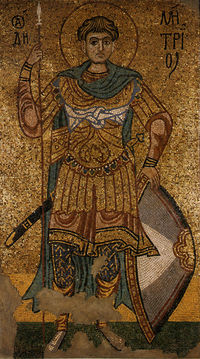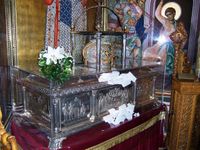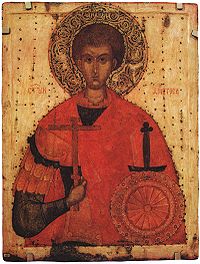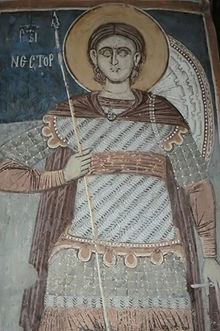- Demetrius of Thessaloniki
-
This article is about the IV century Orthodox saint. For the other saint of the same name, see Demetrius of Alexandria.
Saint Demetrius of Thessaloniki 
12th-century mosaic depicting St Demetrios, from the Golden-Roofed Monastery in KievGreat-Martyr, Myrrh-streamer Born 270 A.D. Died 306 A.D. Honored in Eastern Orthodox Church
Roman Catholicism
Oriental OrthodoxyMajor shrine Thessaloniki, Greece Feast 26 October Attributes depicted wearing the armour of a Roman soldier, usually carrying a spear, often seated on a red horse Patronage patron of Thessaloniki, Greece
patron of soldiers
patron of the Crusades (in Roman Catholic tradition only)Saint Demetrius of Thessaloniki (Greek: Άγιος Δημήτριος της Θεσσαλονίκης) was a Christian martyr, who lived in the early 4th century.
During the Middle Ages, he came to be revered as one of the most important Orthodox military saints, often paired with Saint George. His feast day is 26 October for Christians following the Gregorian calendar and 8 November for Christians following the Julian calendar.
Contents
Name
 Relics of St. Demetrius at the Aghios Demetrios Basilica in Thessaloniki.
Relics of St. Demetrius at the Aghios Demetrios Basilica in Thessaloniki.
The spelling "Demetrius" is a romanization of the ancient Greek pronunciation; the Byzantine and Modern Greek pronunciation is romanized as Dimitrios. See Demetrios for more on the etymology of the name.
In Russian, he is called Димитрий Солунский ([dimitri solunski] 'Dimitri of Saloniki') and was a patron saint of the ruling Rurikid family from the late 11th century on. Izyaslav I of Kiev (whose Christian name was Dimitry) founded the first East Slavic monastery dedicated to this saint. The name Dimitry is in common use.
The Bulgarian Orthodox Church and the Bulgarian people revere St. Demetrius on 26 October as Димитровден (Dimitrovden).
The Serbian Orthodox Church reveres St. Demetrius as Mitar or " Димитрије " , having a feast of Mitrovdan on 8 November. He is known in Lebanon as Mar Dimitri or Mitri for short, which is a common name among Christian Lebanese.
He is known in the Coptic Church as "St. Demetrius of Thessalonica". He is venerated in the Coptic Church on 8 November.
Life
The earliest written accounts of his life were compiled in the 9th century, although there are earlier images of him, and accounts from the 7th century of his miracles. The biographies have Demetrius as a young man of senatorial family who was run through with spears in around 306 AD in Thessaloniki, during the Christian persecutions of the emperor Diocletian or Galerius, which matches his depiction in the 7th century mosaics.
Veneration of Sainthood
The origins of his veneration are obscure; the first evidence comes about 150 years after his martyrdom. Therefore some modern scholars question the historicity of the man.[1]
One theory is that his veneration was transferred from Sirmium when Thessaloniki replaced it as the main military base in the area in 441/442 AD. His very large church in Thessaloniki, the Hagios Demetrios, dates from the mid-5th century, so he clearly had a large following by then. Thessaloniki remained a centre of his veneration, and he is the patron saint of the city.
After the growth of his veneration as saint, the city of Thessaloniki suffered repeated attacks and sieges from the Slavic peoples who moved into the Balkans, and Demetrius was credited with many miraculous interventions to defend the city. Hence later traditions about Demetrius regard him as a soldier in the Roman army, and he came to be regarded as an important military martyr. Unsurprisingly, he was extremely popular in the Middle Ages, and along with Saint George, was the patron of the Crusades.
Some scholars believe that for four centuries after his death, St. Demetrius had no physical relics, and in their place an unusual empty shrine called the "ciborium" was built inside Hagios Demetrios. What is currently purported as his remains subsequently appeared in Thessaloniki, but the local archbishop (John of Thessaloniki, 7th century) was publicly dismissive of their authenticity.[2] These are now also kept in Hagios Demetrios. According to believers, these relics were ascertained to be genuine after they started emitting a liquid and strong scented myrrh. This gave the saint the epithet "Myrovlētēs" (Greek: Μυροβλήτης, the Myrrh-streamer). This has been attested in modern times as well, and the relics continually stream myrrh which has to be collected constantly in order to prevent the reliquary from overflowing. If ever visiting Hagios Demetrius church, one can see a sarcaphagus that is worn down in several areas from the myrrh streaming from his relics.[dubious ]
In the Russian Orthodox Church, the Saturday before the Feast of St. Demetrius is a memorial day commemorating the soldiers who fell in the Battle of Kulikovo (1380), under the leadership of St. Demetrius of the Don. This day is known as Demetrius Saturday.[3]
Iconography
St. Demetrius was initially depicted in icons and mosaics as a young man in patterned robes with the distinctive tablion of the senatorial class across his chest. Miraculous military interventions were attributed to him during several attacks on Thessaloniki, and he gradually became thought of as a soldier: a Constantinopolitan ivory of the late 10th century shows him as an infantry soldier (Metropolitan Museum of Art).[4] But an icon of the late 11th century in Sinai shows him as before, still a civilian. This may be due to iconic depiction customs on how saints are depicted.
Another Sinai icon, of the Crusader period and painted by a French artist working in the Holy Land in the second half of the 12th century, shows what then became the most common depiction. Demetrius, bearded, rather older, and on a dark horse, rides together with St George, unbearded and on a white horse. Both are dressed as cavalrymen. Also, while St. George is often shown spearing a dragon, St. Demetrius is depicted spearing the gladiator Lyaeos, who according to story was responsible for killing many Christians. Lyaeos is commonly depicted below Demetrius and lying supine, having already been defeated; Lyaeos is traditionally drawn much smaller than Demetrius. In traditional hagiography, Demetrius did not directly kill Lyaeos, but rather through his prayers the gladiator was defeated by Demetrius' disciple, Nestor.
A modern Greek iconographic convention depicts Demetrius with the Great White Tower in the background. The anachronistic White Tower acts as a symbolic depiction of the city of Thessaloniki, despite having been built in the 16th century, centuries after his life, and the exact architecture of the older tower that stood at the same site in earlier times is unknown. Again, iconography often depicts saints holding a church or protecting a city that did not even exist when they were alive.
Relic
On June 28, 2007, police recovered a silver box said to contain Demetrius' ankle bone. The relic had been stolen from a Greek Orthodox cathedral that shares his name in Astoria, Queens [5]
See also
Hagios Demetrios, the main sanctuary dedicated to Saint Demetrius
Notes
- ^ Skedros 1996
- ^ Cormack p. 75
- ^ Commemorated on October 24
- ^ [1]
- ^ Police Recover Stolen Church Reliquary
References
- Robin Cormack, Writing in Gold, Byzantine Society and its Icons, George Philip, London, 1985. ISBN 054001085-5
- Eugenia Russell, St Demetrius of Thessalonica; Cult and Devotion in the Middle Ages, Peter Lang, Oxford, 2010. ISBN 978-3-0343-0181-7
- James C. Skedros, Saint Demetrios of Thessaloniki: Civic Patron and Divine Protector 4th-7th Centuries CE, Trinity Press International, 1999. Summarized in Harvard Theological Review 89:410 (1996). in JSTOR
- James C. Skedros, "Response to David Woods" Harvard Theological Review 93:3:235 (July 2000). at JSTOR
- Kurt Weitzmann in The Icon, 1982, Evans Brothers Ltd, London, ills. pp. 32,51,220 (trans of Le Icone, Montadori 1981), ISBN 0237456451
- David Woods, "Thessalonica's Patron: Saint Demetrius or Emeterius?" Harvard Theological Review 93:3:221-234 (July 2000). at JSTOR free copy
- David Woods, bibliography on St. Demetrius
External links
Listen to this article (info/dl)
This audio file was created from a revision of Demetrius of Thessaloniki dated 2006-11-26, and does not reflect subsequent edits to the article. (Audio help)More spoken articles- David Woods, St Demetrius from his Military Martyrs Web site. Includes article on Origins of the Cult, the Passion and Miracles by Anastasius the Librarian (BHL 2122 and 2123), images & links.
- The Life Of The Holy Great Martyr Of Christ Saint Demetrios The Myrrh-Bearer of Thessalonica Compiled by Fr. Demetrios Serfes
- Holy, Glorious Demetrius the Myrrhgusher of Thessalonica Orthodox icon and synaxarion
Categories:- 3rd-century births
- 306 deaths
- 3rd-century Romans
- 4th-century Romans
- Ancient Roman senators
- Christian martyrs of the Roman era
- Eastern Catholic saints
- Eastern Orthodox saints
- Greek Roman Catholic saints
- Greek saints
- Thessaloniki
- People from Thessaloniki
- Saints of Late Roman Thessalonica
Wikimedia Foundation. 2010.



